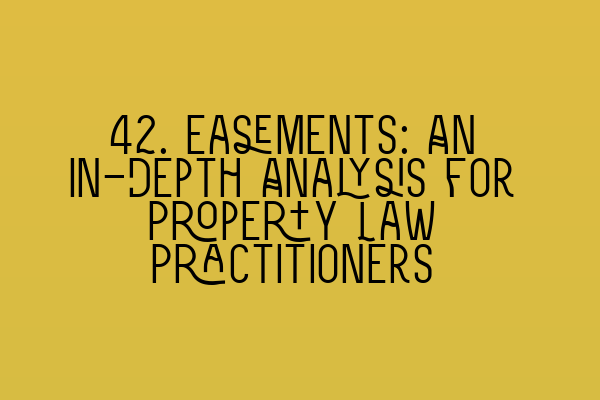**42. Easements: An In-Depth Analysis for Property Law Practitioners**
As property law practitioners, understanding easements is crucial for effectively advising clients and resolving property disputes. In this comprehensive article, we will delve into the intricacies of easements, their legal framework, and their practical implications. Whether you are a seasoned practitioner or a law student preparing for your SQE exams, this in-depth analysis will provide you with valuable insights.
**What are Easements?**
An easement is a legal right to use or enjoy another person’s property for a specific purpose. It grants a non-possessory interest in the land, allowing the easement holder certain limited rights over the land. These rights typically include access, as well as the right to use, maintain, or enjoy the land in a particular way.
**Types of Easements**
There are various types of easements recognized by law, each serving a distinct purpose. Some common examples include:
1. **Right of Way:** This allows a person to pass through or across another person’s land to access a particular destination. It is often seen in situations where neighboring properties have no direct access to a public road.
2. **Easements of Light and Air:** These easements ensure that a property owner maintains their access to natural light and fresh air. They prevent adjacent landowners from obstructing the light and air flow to the affected property.
3. **Easements of Support:** These easements preserve the structural integrity of a building by prohibiting neighboring landowners from altering their land in a way that could undermine the support of the affected property.
4. **Easements of Drainage:** These easements allow the passage of water over one property to another, ensuring proper drainage and preventing flooding or water damage.
5. **Easements of View:** These easements protect scenic views by restricting adjacent landowners from blocking or interfering with the view from a specific property.
**The Creation and Acquisition of Easements**
Easements can be created in several ways, including by express grant, by implication, by prescription, or by statute. A detailed understanding of each method is vital in order to advise clients effectively.
1. **Express Grant:** An easement can be created by the written agreement of the landowner, known as the servient owner, and the person benefiting from the easement, known as the dominant owner. This agreement, which can be a deed or a contract, sets out the specific rights and limitations of the easement.
2. **Implied Easements:** Implied easements may arise when certain conditions are met, such as common intention, necessity, or the previous use of the land. It is important to carefully review the facts and circumstances surrounding the creation of the easement to determine its validity.
3. **Easements by Prescription:** Easements may be acquired through long and continuous use of another person’s land without permission. The use must be open, uninterrupted, and without objection from the servient owner for a specified statutory period.
4. **Statutory Easements:** Some easements can be created by statute, such as public utility easements that grant utility providers the right to access and maintain their infrastructure on private property.
**The Rights and Duties of Easement Holders and Servient Owners**
Easements create a legal relationship between the easement holder and the servient owner, each with their own rights and responsibilities.
1. **Easement Holders:** Easement holders have the right to use and enjoy the land as permitted by the easement. They must exercise their rights reasonably and not exceed the scope of the easement. Easement holders also have a duty to maintain the easement and prevent any excessive or unnecessary harm to the servient land.
2. **Servient Owners:** Servient owners are obligated to allow the easement holder to exercise their rights as defined in the easement. However, servient owners have the right to use their land in a way that does not unreasonably interfere with the easement holder’s enjoyment. They must not obstruct or impede the exercise of the easement rights.
**Enforcement and Termination of Easements**
Easements can be enforced through legal action if their rights are violated or if disputes arise between the parties involved. Conversely, easements can be terminated under certain circumstances, such as through expiration, merger, release, abandonment, or by court order.
**Conclusion**
Easements play a fundamental role in property law, granting individuals and entities specific rights over another’s land. As property law practitioners, it is essential to have a thorough understanding of the legal framework surrounding easements and their practical implications for clients. By properly advising clients on easements, you can ensure their property rights are safeguarded and potential disputes are managed effectively.
For further preparation on property law and other SQE exam topics, we recommend checking out our related articles:
– [SQE 1 Practice Exam Questions](https://fqps.co.uk/sqe/sqe1-preparation/mcq-practice-quiz)
– [SQE 1 Practice Mocks FLK1 FLK2](https://fqps.co.uk/sqe/sqe1-preparation/practice-mocks-quiz)
– [SQE 2 Preparation Courses](https://fqps.co.uk/sqe/sqe2-preparation)
– [SQE 1 Preparation Courses](https://fqps.co.uk/sqe/sqe1-preparation)
– [SRA SQE Exam Dates](https://fqps.co.uk/sqe/sqe1-sqe2-exam-dates)
At SQE Property Law & Land Law, we are dedicated to providing comprehensive resources and expert guidance to help you excel in your property law practice and SQE exams. Stay tuned for more informative articles and valuable insights into property law topics.
